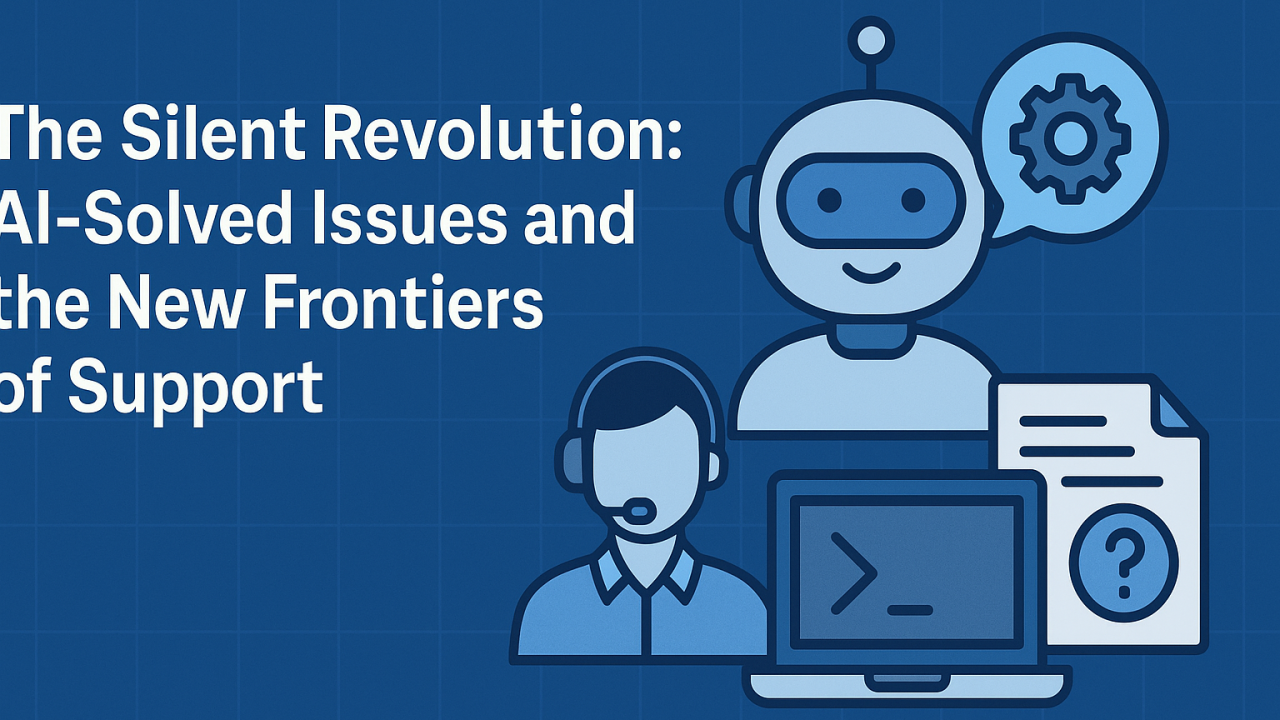AI-Solved Issues and the New Frontiers of Support

Artificial Intelligence is transforming customer support in ways that are both obvious and invisible. Chatbots, self-healing systems, and AI copilots are already resolving issues before they ever reach a human. On the surface, this seems like a net win: fewer tickets, faster resolutions, and happier customers. But there’s a quieter revolution happening in the background—one that leaders in support must urgently prepare for.
We are entering an era where the issues support teams used to solve are disappearing, while entirely new categories of problems are emerging. This shift isn’t just operational—it’s existential. It challenges what support is, who it’s for, and what skills are required to deliver it.
Part I: The Problems That Vanish
Let’s start with the kinds of issues AI is silently eliminating:
1. Repetitive Troubleshooting Tasks
“Try turning it off and on again” is now handled by a chatbot. So are password resets, basic configuration problems, and simple how-to queries. AI tools parse documentation, understand error messages, and offer real-time fixes without a human in the loop.
2. Predictable Failure Modes
Modern software often integrates telemetry and predictive diagnostics. When an AI agent detects that a system is likely to fail—say, a server approaching disk space limits—it can alert the user or automatically resolve the issue. This makes traditional monitoring-based support less relevant.
3. Knowledge Gap Queries
Many support tickets arise because users don’t know how to navigate or use a product effectively. Generative AI assistants embedded in apps are beginning to fill these knowledge gaps instantly. Users no longer need to contact support to ask, “Where can I find this setting?”
These eliminated tickets may never be counted—but they represent thousands of hours of saved effort across support organizations.
Part II: The Problems That Emerge
But here’s the twist: AI doesn’t eliminate complexity. It moves it. And often, it creates entirely new types of problems:
1. AI Misfires and Hallucinations
When a chatbot gives the wrong solution with confidence, users may take destructive actions—deleting the wrong config file, changing settings incorrectly, or overriding safeguards. Human support teams must now untangle these “second-order failures” caused by misguided AI.
2. Over-Reliance on AI Outputs
Customers (and junior support reps) increasingly rely on AI to produce scripts, commands, or config changes. But AI sometimes produces outdated or context-inappropriate responses. Support teams must validate, debug, and explain code or queries users found online—even if the customer doesn’t understand them.
3. Systems Interoperability and Edge Cases
As software ecosystems become more complex, AI can't always predict how integrations behave across unique customer environments. These edge cases will be increasingly common and nuanced—requiring high-context, analytical thinkers to diagnose and resolve them.
Part III: The Skills We Now Need
As the nature of support changes, so too must our teams. The AI era demands a new kind of talent.
🧠 Systems Thinking
Future support analysts must understand the interplay between systems, APIs, and platforms. Troubleshooting will become less about resolving one issue and more about mapping the flow of failure across interconnected components.
🛠️ Prompt Engineering & AI Literacy
Support professionals must learn to use AI as a tool—not a crutch. This includes understanding how to craft effective prompts, validate AI-generated output, and intervene when things go wrong.
🧬 Soft Skills at a Premium
With AI handling low-empathy tasks, humans are left with the high-stakes ones. This means escalation conversations, guiding confused or angry customers, and restoring trust after automation fails. Emotional intelligence and strategic communication become critical.
⚙️ Toolchain Mastery
The rise of AI copilots means support teams must also know how to configure, extend, and sometimes debug the AI tools themselves. Support will blur into engineering, operations, and product.
Part IV: This Has Happened Before
We’ve seen this before. When self-service portals became popular in the early 2000s, support leaders feared that teams would shrink. But what actually happened? The nature of support changed. Level 1 issues declined—but Level 2 and 3 became more important. In turn, roles like “Technical Account Manager” and “Customer Success Engineer” grew rapidly.
Similarly, when DevOps matured, operations teams didn’t disappear—they upskilled. The best ones learned infrastructure-as-code, automation pipelines, and cloud orchestration. They became more technical and more critical.
The same will happen in support. AI will eliminate the grunt work—but it will elevate the thinking work.
Part V: What Support Leaders Must Do Now
Support leaders must now:
- Audit their team’s skill inventory. Who’s AI-literate? Who can analyze systems? Who can explain complexity simply?
- Create AI upskilling programs. Prompt engineering, AI safety practices, and co-pilot tools should be part of ongoing training.
- Partner with Product & Engineering. To solve future problems, support must sit upstream in the software lifecycle.
- Shift hiring profiles. Look beyond troubleshooting experience. Hire curious, adaptable thinkers who thrive in ambiguity.
Final Thought: The Invisible ROI
AI is already saving time in ways your metrics don’t capture. But if your team isn't evolving fast enough, those hidden gains may be offset by the rising cost of unresolved complexity.
We are standing on the edge of a new support paradigm. The question isn’t whether AI will change the game—it already has. The question is whether your team is ready for the next level.

